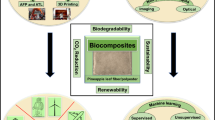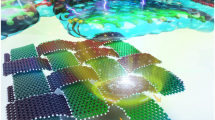Abstract
Nonwoven structures have been recently explored for numerous novel applications ranging from composites to scaffolds. The tensile property of nonwovens is a pre-requisite and indeed, one of the main parameters to determine their performance for such applications. In the first part, a modified micromechanical model describing the tensile behaviour of thermally bonded nonwovens was proposed by incorporating the effect of fibre re-orientation during the deformation (Rawal et al., J Mater Sci 45:2274, 2010). In this study, an attempt has been made to compare the theoretical and experimental stress–strain curves of thermally bonded and spunbonded nonwoven structures. These theoretical findings have been obtained from the most popular analytical tensile models of nonwovens available in the literature in addition to our modified tensile model. Poisson’s ratio has also been determined experimentally in order to predict the stress–strain behaviour of nonwoven, and its relationship with longitudinal strain has clearly distinguished between the randomly and preferentially orientated types of structures. In thermally bonded nonwovens, the tensile strength in various test directions is computed through pull-out stress and a comparison is made with the experimental results.











Similar content being viewed by others
References
Lukić S, Jovanić P (2004) Mater Lett 58:439
Patnaik A, Tejyan S, Rawal A (accepted) Soil erosion behaviour of needlepunched nonwoven reinforced composites. Res J Text Appar
Engelmayr GC, Sacks MS (2006) J Biomech Eng 128:610
Backer S, Petterson DR (1960) Text Res J 30:704
Hearle JWS, Stevenson PJ (1963) Text Res J 33:877
Hearle JWS, Stevenson PJ (1964) Text Res J 34:181
Bais-Singh S, Goswami BC (1995) J Text Inst 86:271
Kim HS (2004) Fibers Polym 5:139
van Wyk CM (1946) J Text Inst 37:T285
Komori T, Makishima K (1977) Text Res J 47:13
Komori T, Makishima K (1978) Text Res J 48:309
Pan N (1993) Text Res J 63:336
Pan N, Chen J, Seo M, Backer S (1997) Text Res J 67:907
Mueller DH, Kochmann M (2004) Int Nonwovens J 13:56
Limem S, Warner SB (2005) Text Res J 75:63
Hou X, Acar M, Silberschmidt VV (2009) Comput Mater Sci 46:700
Demirci E, Acar M, Pourdeyhimi, B, Silberschmidt VV (in press) Comput Mater Sci. doi:10.1016/j.commatsci02:039
Hou X, Acar M, Silberschmidt VV (in press) Comput Mater Sci. doi:10.1016/j.commatsci.2010.03.009
Rawal A, Priyadarshi A, Lomov SV, Ngo T, Verpoest I, Vankerrebrouck J (2010) J Mater Sci 45:2274. doi:10.1007/s10853-009-4152-x
Pan N (1993) J Text Inst 84:472
Jones RM (1975) Mechanics of composite materials. McGraw-Hill, New York
Rawal A, Lomov SV, Ngo T, Verpoest I, Vankerrebrouck J (2007) Text Res J 77:417
Rawal A, Lomov SV, Verpoest I (2008) J Text Inst 99:235
Rawal A (2006) J Ind Text 36:133
Acknowledgements
The authors gratefully acknowledge the companies, i.e. Libeltex BVBA and Colbond for providing thermally bonded and spunbonded nonwoven samples, respectively.
Author information
Authors and Affiliations
Corresponding author
Rights and permissions
About this article
Cite this article
Rawal, A., Priyadarshi, A., Kumar, N. et al. Tensile behaviour of nonwoven structures: comparison with experimental results. J Mater Sci 45, 6643–6652 (2010). https://doi.org/10.1007/s10853-010-4755-2
Received:
Accepted:
Published:
Issue Date:
DOI: https://doi.org/10.1007/s10853-010-4755-2




